Dear Reader, in this age of AI created content, please support with your goodwill someone who works harder to provide the human-made. Sign up at the top of the lefthand column or bottom of this page. You will receive my hand illustrated monthly newsletter RESTORE NATURE and access to the biodiversity garden design course as I write...and nothing else, I respect your time. I am also removing the advertizing as best I can as its become intrusive inappropriate and pays me nothing.
Recycling grey water in a DIY wicking bed
 The process of recycling grey water is aided by plants. Here we have Cocoyam or Amadumbe, sorghum, wild peas and mint thriving while they clean the water.
The process of recycling grey water is aided by plants. Here we have Cocoyam or Amadumbe, sorghum, wild peas and mint thriving while they clean the water.The book "DIY Grey Water Wetland"
will be on special soon.
Please thank us with a review !
For all readers who may want to buy the book, which I have just published, here is a special bargain. For just one week, the book will be free of charge. The reason is that we want to spread the knowledge and we also need some reviews to get the word out and inform future customers about the book. Your intelligent review is urgently needed and as a thank you, I'm releasing the book free for a short time, to give potential readers a chance to buy and review. Your contribution will be really appreciated. I read all my reviews and it will really help with future writing.
Why recycling grey water is so important
In the summer of 2017-2018, the city of Cape Town with its population of four and a half million nearly ran out of water, due to a drought. With the drama around day Zero, many people changed their attitude to water. Permaculturists like Guerilla House spread knowledge of numerous water saving mechanisms in urban homes. I became convinced of the necessity of recycling grey water and putting it to use in our garden, instead of letting it go into the municipal waste water system. The reasons for this were many, as outlined in the book I wrote on our first grey water system, so I will only give the main points here. The waste water that leaves the home goes to a water purification plant or straight out to sea. Grey water is a major part of the waste water produced in a home, from half to more than half of the volume of waste water. It can be diverted from entering the sewer that leaves a property without too much danger to health and with huge pluses for making the city a verdant, rain attracting zone. Recycling grey water can be integrated with growing vegetables, which are almost all exotic, and in our climate and low nutrient soil at the Cape are water and nutrient intensive. This not only saves water but gives added food security to a home in the Western Cape's urban drought zone, and more water security to the greater community, in the desertified city of Cape Town.
Background to the book on recycling grey water
So, because of drought crisis, I built two grey water biofilter systems, and then wrote a manual about recycling grey water that teaches other people how to build : DIY Grey Water Wetland: How to build a permaculture inspired, drought tolerant, kitchen water filtering, raised bed vegetable garden and wetland. The book has a long title, there are too many ideas to incorporate into that short space. In the book I argue that recycling grey water in water holding systems for growing food is useful in multiple ways: it cleans grey water, can be built in adherence to the law and anyone with a small budget for materials (R2600 was enough for my system) can build. Clever recyclers could take material costs down to zero.
The first system for recycling grey water, on which the book is based, takes the kitchen waste water. The book outlines the many benefits to the soil, environment, health and household budget of such a system, and details how it was built and the materials used with pictures and diagrams for clarification. Extensive notes, glossary and trouble shooting discussion add to the learning experience provided by my experience. You can access more information on the book through the Kindle link in the side bar.
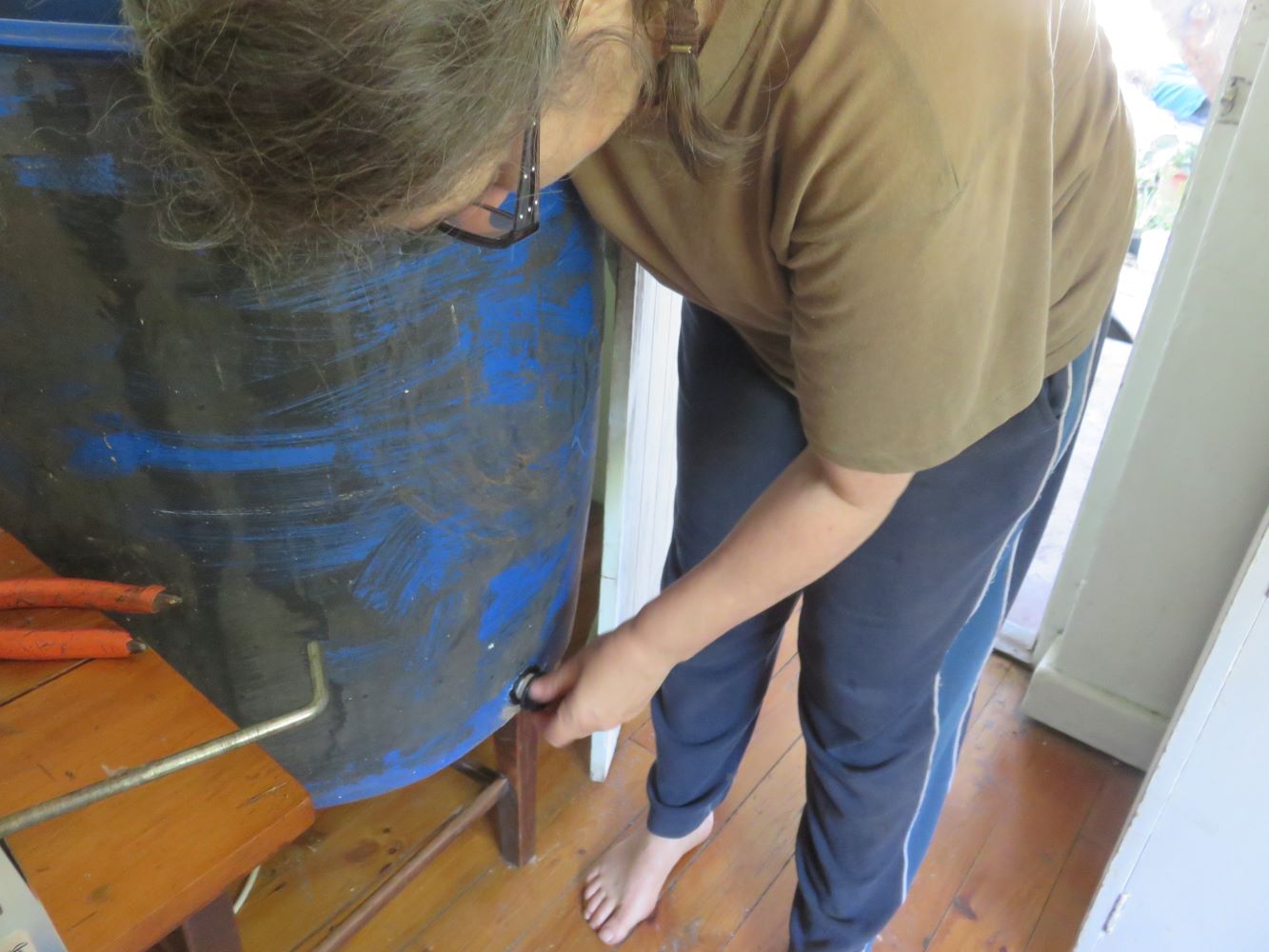 Here I am inserting a flushing valve to remove organic sediment from the fat digester.
Here I am inserting a flushing valve to remove organic sediment from the fat digester.Recycling grey water and moving towards going off grid
In urban houses, most frequently recycling grey water constitutes using the less contaminated components of grey water like lag water and washing machine rinse cycles for toilet flushing. People with the means generally put this water in a special tank and knock it with chlorine bleaches so that it can be stored 'safely' for use in the toilet.
As I felt this form of recycling grey water was not complete enough, and too reliant on the grid, and the bleach part of it didn't seem very environmentally friendly to me, the permaculture inspired option of leading grey water to the garden was more desirable. However, I read that grey water, charged with soap ingredients, can make the soil it irrigates infertile over a period of decades. This direct grey water irrigation seemed unsustainable to me in the long view without some adaption. Salty soil can be remediated with vermicompost, and this has been tested in Australia, but remediation is costly and unnecessary if we avoid contaminating the soil with excess minerals in the first place. This is when I stumbled across grey water biofiltration. The biofiltration systems are almost exclusively found in rural setups where space is not at a premium, and laws on waste water are applied less rigorously. The systems I've built are for easy, safe, space conscious and legal maintenance in an urban setting.
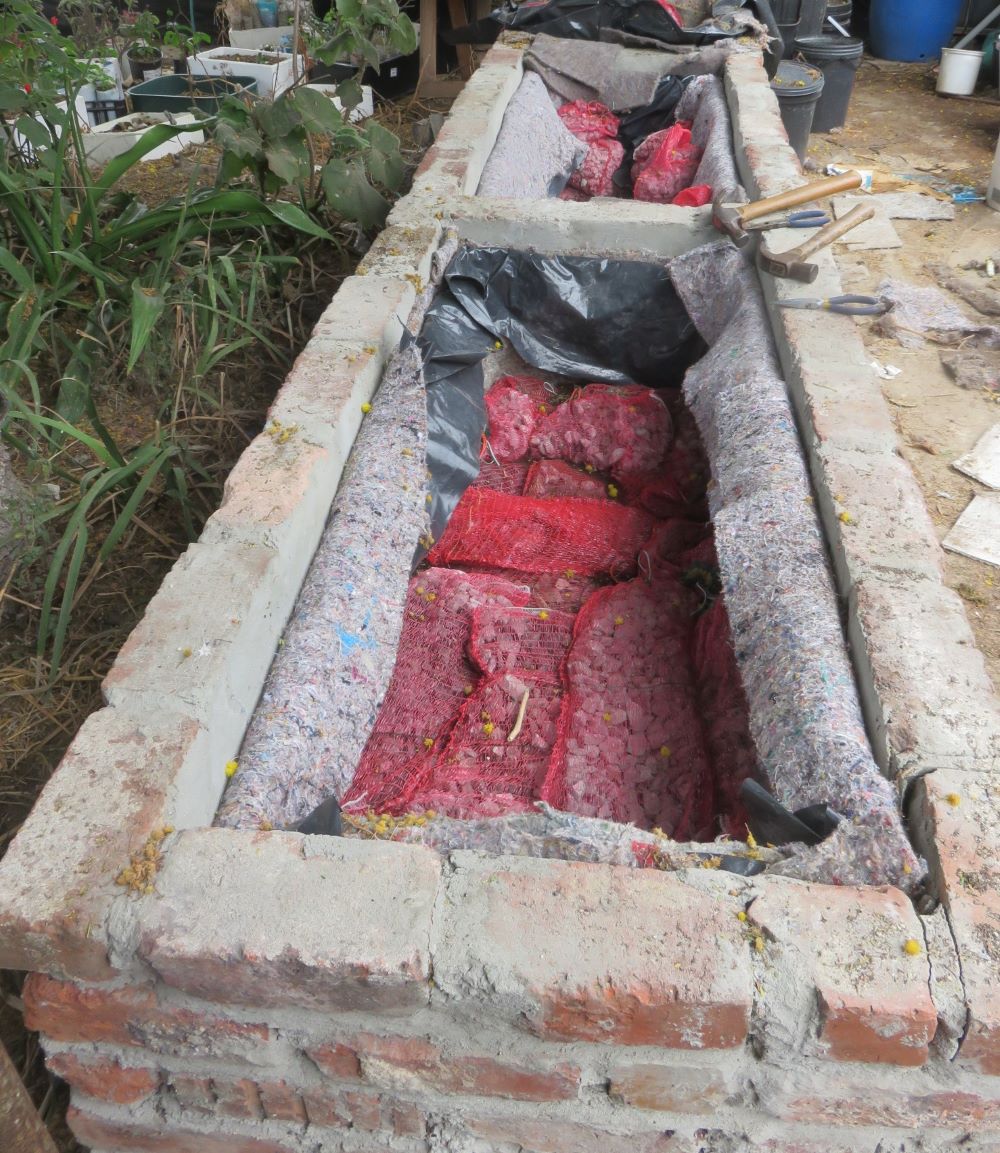 The raised wicking beds are built, lined, and filled with gravel in bags, waiting for the water to back up. The next stage is filling the tanks with soil and plants.
The raised wicking beds are built, lined, and filled with gravel in bags, waiting for the water to back up. The next stage is filling the tanks with soil and plants.After leaving the house, grey
water can be filtered, cleaned up
and re-used for irrigation and toilet flushing, and other medium or low
pathogen risk functions. I explain the city's risk categories in the
book. With extreme
filtration, and sanitizing with heat, the cleaned grey water could even
go back to for use in the house other than drinking. The last is safe and possible but not legal here. Using
only rain water as input to the home would be another means of saving
water. As described in the previous article that overviews household water streams, recycling grey water, saving a lot of rain water and using safe dry toilets could mean total
independence from mains water.
Most commonly grey water is a by product of mains
water use. In our home too, until we can afford larger rain tanks, our water source is mains water. Generally our mains water goes through hand washing,
laundry washing, showering or dish washing and is then guided to the biofilters for recycling grey water. It irrigates plants growing in the filters and much is consumed
by transpiration. If there is a water surplus, and water flows out of the grey water
filter, it is collected in buckets for toilet flushing. When it leaves
the grey water system the output water is odorless and clear, slightly
amber colored from plant tannin. It is so clean it does not even attract mosquitoes, let alone flies who like a heavier nutrient load. If it is tested and found pathogen and toxin free, and without excess mineral salts, it can be used for irrigating the garden.
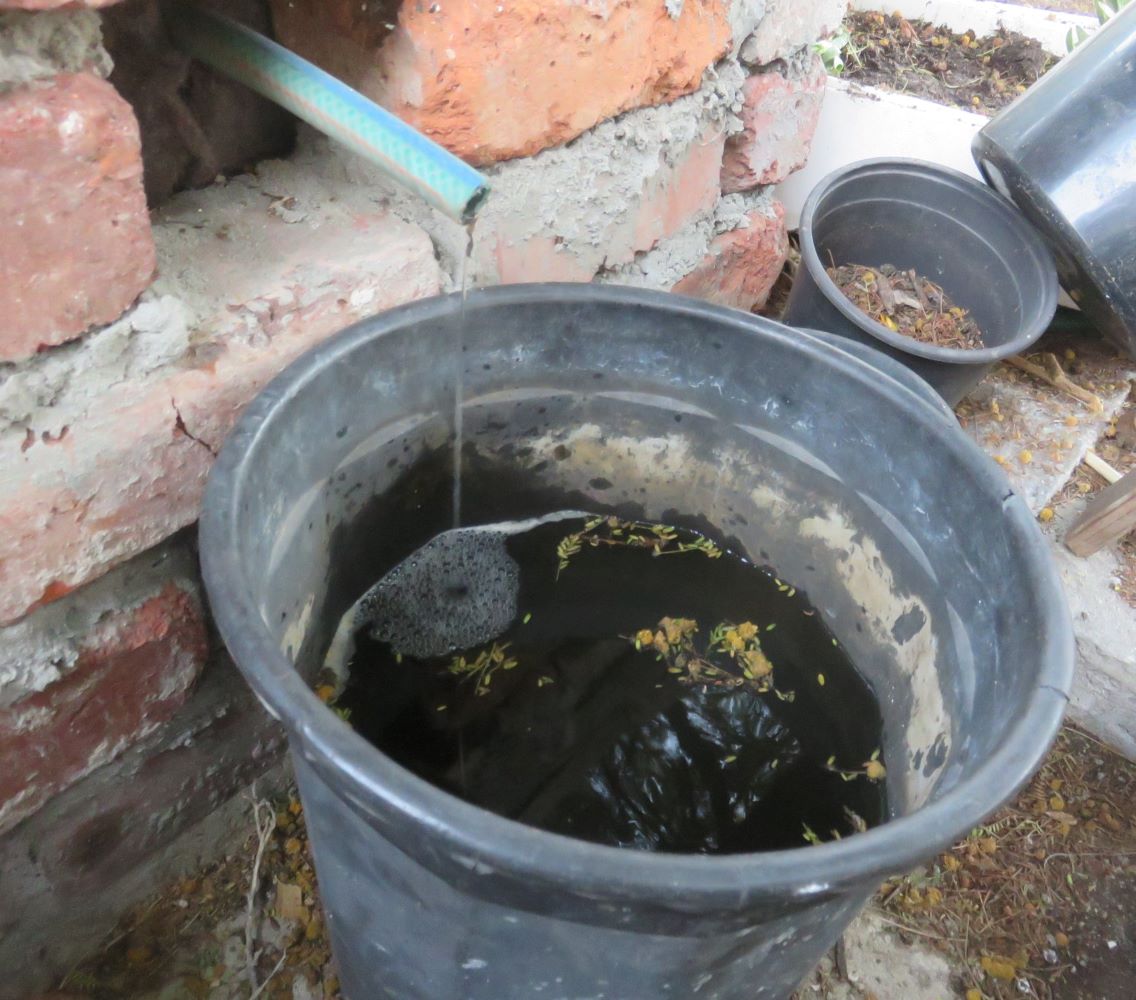 At the end of the system, when recycling grey water is complete, the water runs out clear and odorless, and is collected for flushing.
At the end of the system, when recycling grey water is complete, the water runs out clear and odorless, and is collected for flushing.Contaminants in grey water
Removing contaminants from grey water with biofiltration is tried and
tested. There are many other people who have
built systems for cleaning grey water biologically. The action of microbes and plants can remove most
of the harmful contaminants from soaps before the water is led into the garden for food growing. The
main contaminants in grey water are salts with sodium, potassium and phosphorus, pathogens mainly found in traces of fecal matter, organic solids and toxic industrial molecules found in cleaning agents.
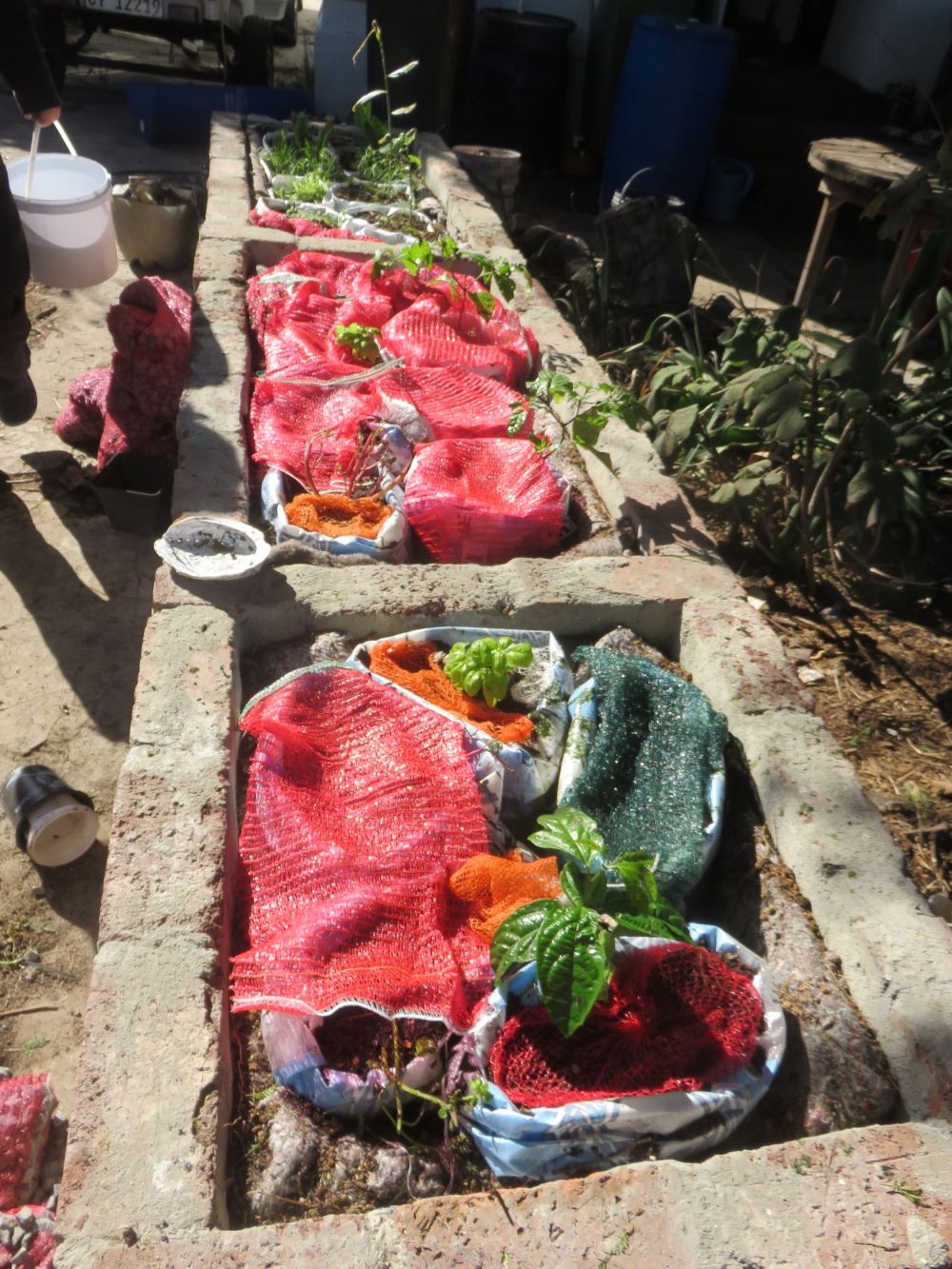 Cover crops, covered with nets, have been planted in the wicking beds. The water is never exposed, until it is clean. Plants will help remove excess nutrients from the water and oxygenate it.
Cover crops, covered with nets, have been planted in the wicking beds. The water is never exposed, until it is clean. Plants will help remove excess nutrients from the water and oxygenate it.Sodium and Phosphates
As far as soil fertility is concerned, sodium, chlorides, phosphates and boron are the main dangers in grey water. In the long term grey water can make the soil saline, or salty. Sodium is the main ingredient of many soaps in the form of Sodium hydroxide or soda ash. If the sodium ions bond with chlorine in the water they will form salt or sodium chloride. Some authorities recommend growing salt tolerant plants if grey water irrigation is used. This seems a rather fatalistic approach. Rather avoid the use of sodium in the first place. If instead of sodium hydroxide, soaps based on potassium hydroxide, or potash, are used, the potassium can be absorbed by the plants. It is a macro nutrient, whereas sodium is not. The other macro nutrients in the NPK relationship, phosphorus and nitrogen, can be supplied by adding a little urine to the grey water. Phosphates are also a major constituent of commercial soaps and are especially persistent in soil and contribute to infertility, and phosphate containing soaps need to be used very sparingly so that the plants can absorb them. If the formula is balanced there will be lush growth in the grey water system, and the leaves can be harvested and eaten or used for mulch, which will slowly release the nutrients back into the soil at a rate manageable by soil bacteria and natural processes of degradation and filtration.
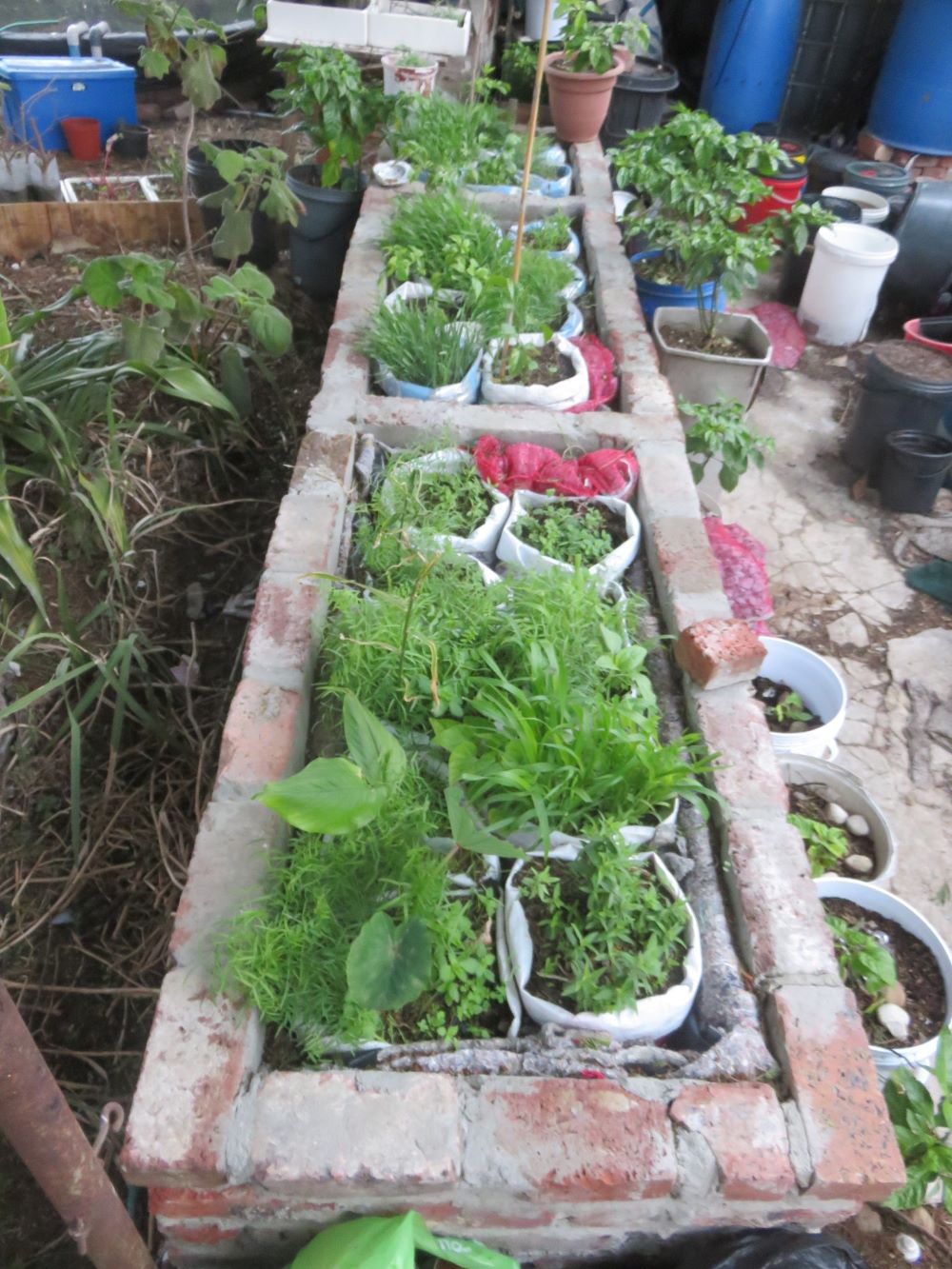 After a few weeks the roots of the cover crops have reached the water below, and are thriving. The wild peas, sorghum, sunflowers and buckwheat are interplanted with Colocasia and mint.
After a few weeks the roots of the cover crops have reached the water below, and are thriving. The wild peas, sorghum, sunflowers and buckwheat are interplanted with Colocasia and mint.Fecal matter
In the nutrient rich environment grey water supplies, microorganisms can bloom and traces of fecal matter can supply a source of pathogens which multiply.
Fecal matter is more of a problem in shower and hand basin water, and less of a likelihood in kitchen grey water. We are most used to our own bacteria. Generally the fecal contamination is most dangerous when people outside the family are exposed to our grey water, and expanding infection can occur, leading to epidemics. Children, the aged, patients on immune-suppressant medication, and HIV sufferers are especially vulnerable.
To avoid infection risk in urban areas, running the grey water through a biofilter is useful. Earthworms and microbes can remove a lot of the pathogens like E-coli and salmonella by consuming or out-competing them. However, as in our system, it is vital to ensure that your grey water does not get exposed and become a source of infection to the neighbourhood through flies. The water must be led underground even in the filter system, until it is no longer attractive to flies or mosquitoes. It must also be led underground or in low pressure drip systems if it is used for irrigating the garden, and must never be allowed to pool on the surface or run off the property, according to city regulations.
Organic material and fats
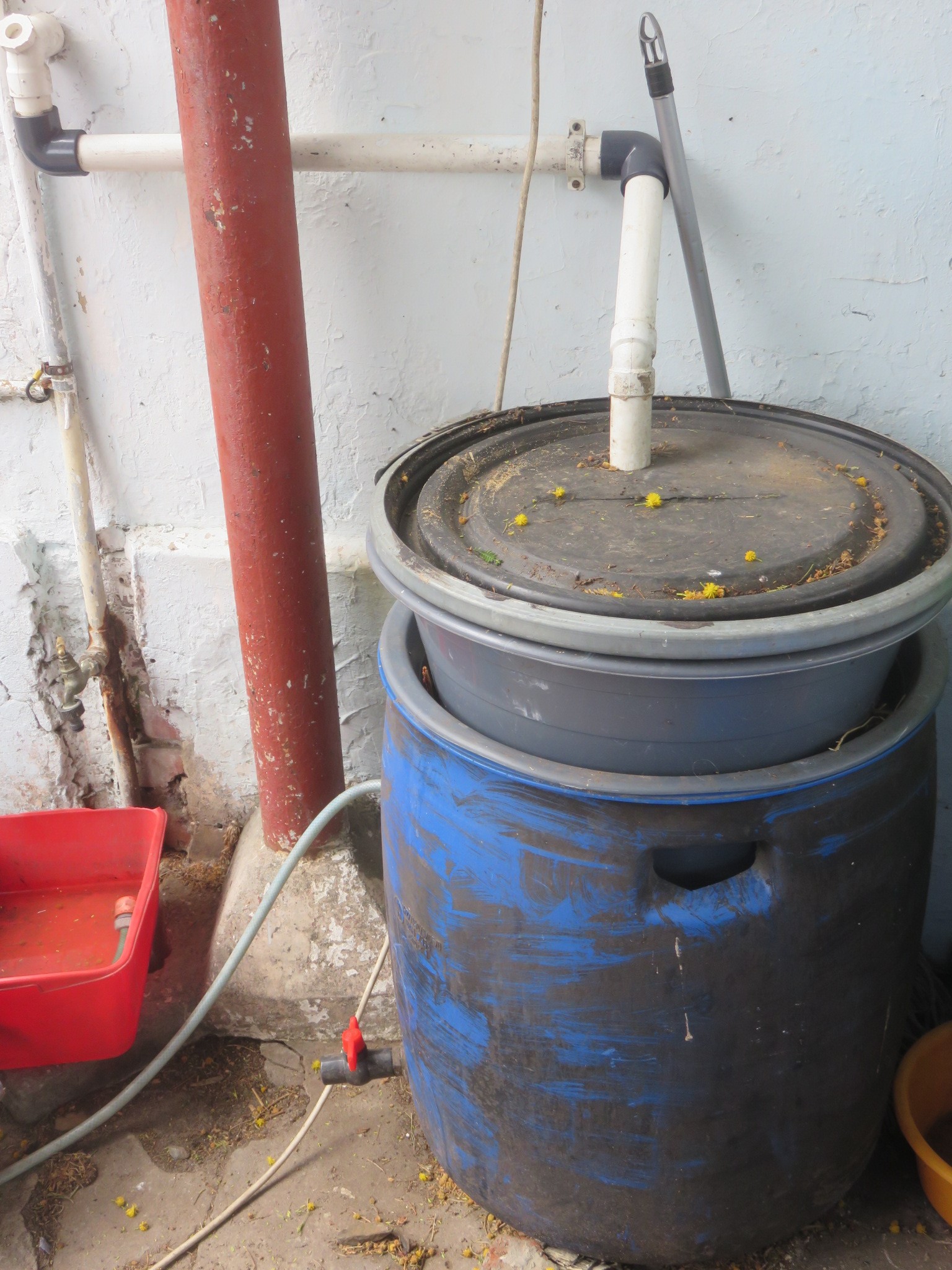 The first stage of recycling grey water from the kitchen: worm bin trays and fat-digester barrel.
The first stage of recycling grey water from the kitchen: worm bin trays and fat-digester barrel.Excess organic material and fats are a contaminant in kitchen waste water primarily. A worm bin can receive this water and the worm bedding will filter out the fat and food particles, which the worms then consume. With moderate fat use in the kitchen, they seem to manage, our worms are very active, large and numbers are growing. We also have a backup fat digester in the barrel below the worm farm, which I discuss in the book I wrote on this system.
Cleaning chemicals
Cleaning chemicals are so bad for human and environmental health in many ways. Over sanitizing reduces gut flora diversity and petro-chemicals and plastics in water bodies downstream often disrupt metabolic processes in humans and animals. They may have a direct impact on respiratory tract and skin disease, cancer and many other illnesses. Germicidal cleaning agents will also kill the microbes in the biofilter. You can switch to vinegar and bicarb for most cleaning in the home. Vinegar is an excellent toilet cleaner. It quite painlessly washes away brown encrustations, if you are patient and expose the toilet to vinegar several times. It also sanitizes kitchen surfaces but not so thoroughly as to endanger your gut microbiome too. Bicarb and vinegar put paid to baked on grime on the stove and in the oven. Just apply and wipe away, no elbow grease is required. Once again, several applications are needed, but when you think how it saves your health and produces environmentally friendly grey water its all worth it. Bicarb can clean silver too.
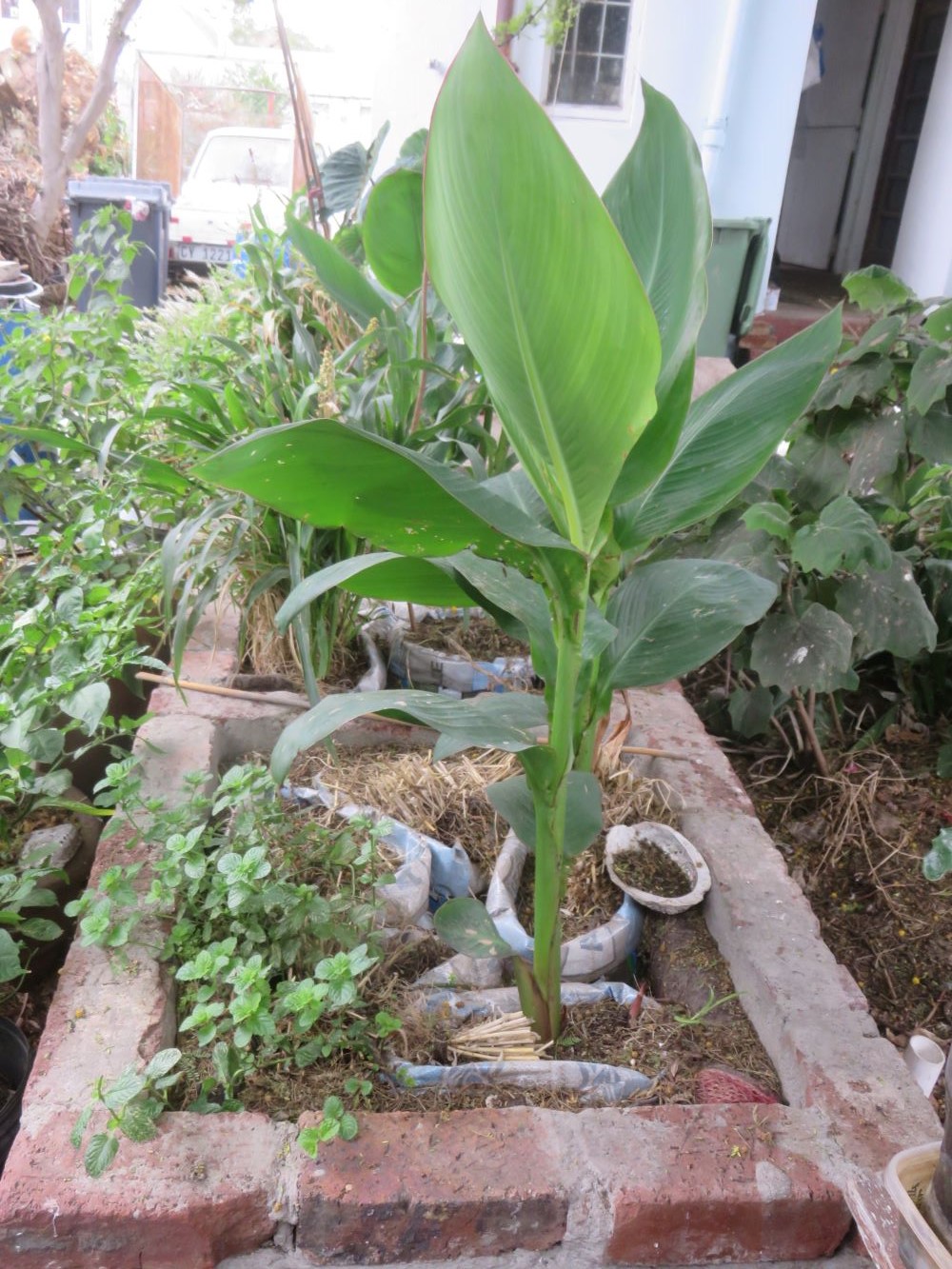 After a year in operation, the cover crops have been cut and used as mulch and replanting is needed. We had good crops of mint, sorghum, cocoyam and large purple cherokee tomatoes.
After a year in operation, the cover crops have been cut and used as mulch and replanting is needed. We had good crops of mint, sorghum, cocoyam and large purple cherokee tomatoes.Please let me know what you think
This is the story of how I came to build two large grey water biofilters, one for the kitchen and one for the bathroom and laundry. It is also the story of how the grey water filters have neatly dovetailed into my housekeeping without causing me extra effort. Once built, the maintenance on my systems is negligible. I gave a workshop and then wrote a manual outlining how I built the first system which you can access on kindle here, or via the sidebar. Please contact me with any questions, comments, experiences and queries about needs for your grey water recycling. I'm always happy to talk with people about biofiltration and exchange ideas free of charge. To get hold of me you can use the C2 comment boxes on this website or the facebook link.
What kind of grey water recycler
are you ?
------
home page for links to many articles on natural gardening, permaculture and environment
------
------
You’re a home gardener ! Share your experiences and questions !
We all know about home gardening. Tell us about your successes, challenges and ask about issues that bother you. You may have the luxury of a back garden, but there are other ways we learn. Few people age without growing something or buying vegetables during their lives ! It is absolutely guaranteed that you have learned things which can help others on their gardening journey.
We invite you to share your stories, ask questions, because if a thing has bothered you it will bother others too. Someone may have a solution ! No question is too small. There is learning for everyone involved, for you, for me (yes, I learn from every question), for us all. Exciting stuff !
We are starting on a new journey. Every week we will profile your letters ! The best stories and questions we receive.
What Other Visitors Have Said
Click below to see contributions from other visitors to this page...
Grey water system off grid tiny home 




Hi
I bought an off grid property, as septic tanks are expensive to install and maintain, I am looking at a more sustainable method of reusing grey water …
Enjoyed your book, 




Hi! My name is Claudia McBride. I live in the state of Oklahoma in the U.S. I live in the eastern part of the state which usually gets plenty of rain but …
Enjoyed your book, "DIY Grey Water Wetland" 




Hi! My name is Claudia McBride. I live in the state of Oklahoma in the U.S. I live in the eastern part of the state which usually gets plenty of rain but …
Grey water wicking bed systems and troubleshooting 




Hi Riaan
Some things which may help your conceptualization.
From experience using a grey water wicking bed as a filter and water cleaner
TRANSPIRATION …
Restore Nature Newsletter
I've been writing for four years now and I would love to hear from you
Please let me know if you have any questions, comments or stories to share on gardening, permaculture, regenerative agriculture, food forests, natural gardening, do nothing gardening, observations about pests and diseases, foraging, dealing with and using weeds constructively, composting and going offgrid.
SEARCH
Order the Kindle E-book for the SPECIAL PRICE of only
Prices valid till 30.09.2023
Recent Articles
-
garden for life is a blog about saving the earth one garden at a time
Apr 18, 25 01:18 PM
The garden for life blog has short articles on gardening for biodiversity with native plants and regenerating soil for climate amelioration and nutritious food -
Cape Flats Sand Fynbos, Cape Town's most endangered native vegetation!
Apr 18, 25 10:36 AM
Cape Flats Sand Fynbos, a vegetation type found in the super diverse Cape Fynbos region is threatened by Cape Town's urban development and invasive alien plants -
Geography Research Task
Jan 31, 25 11:37 PM
To whom it may concern My name is Tanyaradzwa Madziwa and I am a matric student at Springfield Convent School. As part of our geography syllabus for this
"How to start a profitable worm business on a shoestring budget
Order a printed copy from "Amazon" at the SPECIAL PRICE of only
or a digital version from the "Kindle" store at the SPECIAL PRICE of only
Prices valid till 30.09.2023







